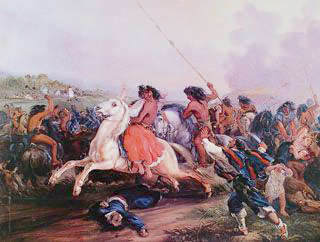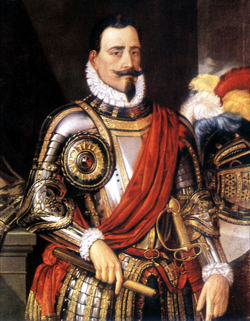
The Arauco War

In 1531 the conquistador Don Diego de Almagro arrived in Chile in a reconnaissance mission. So far the conquest of the Inca Empire in Peru and Aztec Empire in Mexico had proved that the indians did not put up enough of a fight to maintain their independence, and they believed that it would be same all over the continent.
But the Incas had attempted to conquer the Mapuches before the Spaniards set foot in the southern lands that one day would be known as Chile. The Mapuches fought long and hard and in the end the empire relented and set their limits north of the Maule river.
The Spaniards' superiority in arms and the surprise effect caused by men mounting horses was effective when the first military confrontation occurred in the same year in Reynogüelén. The Mapuches believed at first that they were strange creatures, half-horses and half-men. It turned out an easy victory for Diego de Almagro and his men.
The next conquistador that came was Pedro de Valdivia, natural from Extremadura. Apparently it was his ambition of power that drove him south of Peru, he wanted to conquer land, conquer the natives and get their gold. But the Mapuches and other native ethnics (mainly pehuenches, huilliches and picunches) recovered quickly. They were prepared the next time, when conquistador Pedro de Valdivia came to Chile in 1541, the Picunche cacique Michimalonco attacked the recently founded city of Santiago.
News of Michimalonco's success reached far and wide and it infused strength to several native tribes who were ready to oppose the conquest and refused to subject themselves to Spanish rule.
A few years later Pedro de Valdivia, in order secure Santiago and to extend the territories in his jurisdiction decided to set out on an expedition to Araucania, giving way to the Arauco War.
Despite Chile's abundant rainforest and vegetation, food in form of vegetables and animals and its many natural beauties the Spanish only looked for gold, and at the lack of it they agreed it was not a Spanish summer camp. Many wanted to return as they felt that it was a hostile rather than fertile land and were fe up of Pedro de Valdivia’s tyrannical leadership.
The Arauco War begins
In 1546 Pedro de Valdivia went as far as river Bio-Bio, accompanied by an entourage of 60 horse riders and thousands of Indians. They were attacked by the Mapuche, commanded by Toki (a warlord chosen by the people as a military leader) Malloquete. Valdivia decided to retreat, as his numbers were greatly inferior and he feared they could be annihilated.
But the Arauco war wasn't over. Pedro de Valdivia founded cities and set up forts in Mapuche territory, thinking it would be a way to subject them. He did have military victories which allowed them to establish the cities of Concepción, Valdivia and Villarrica
A young man, Lautaro, had served as a page boy for the Europeans. He learned Spanish and gained much knowledge of the ways of the Spanish army. He escaped and his fellow Mapuches elected him as military leader. He knew that the Spanish were drawing south and he decided to prepare an ambush. He lied to the Spanish soldiers who were in Fort Purén and who according to Valdivia's orders were to meet the company in Fort Tucapel.

Pedro de Valdivia left Concepción in 1553. The Mapuche spies reported back to Lautaro after their stakeout. Valdivia was surprised that the Mapuches allowed themselves to be seen but do not attack. Also he receives no news from Fort Tucapel. After a while he got suspicious and sent an outpost that did not return.
On the next day Valdivia was even more surprised when his patrol still hadn't returned. They continued on their way to Tucapel and when they reached it they found it completely destroyed. While he set up camp in the ruins of the fort, the surrounding woods filled with shouts and cries of war, and with no more warning the Mapuches, who had been hiding, run towards the fort and the conqueror. The Spaniards were greatly outnumbered.
It is said that the it was the best Spanish class of warfare, and in fact held their lines through the first attack of the Mapuches. But just when they thought they had won, a second attack followed. There were casualties on both sides and then the Mapuches retreated once more. But once again, a third squadron charged.
The battle became even bloodier. Half the Spanish men were dead, the auxiliary indians' numbers dwindled. Pedro de Valdivia, who was an experienced warlord knew that their situation was desperate. When he realized the battle was as good as lost he told his remaining forces to retreat. Only Valdivia himself and a priest managed to escape capture, however when they crossed some swamps, the horses got stuck and then, they did get capture.
What happened next is a little uncertain, we only know for sure that the Mapuche killed Pedro de Valdivia. There are many myths of how they executed him, some say they tortured him for days and ate his heart, others say that they gave him molten gold to drink, since he wanted it so much, though what's more likely is that they gave him a clean death. They did not want revenge, they wanted the Spaniards out of their lands and Pedro de Valdivia was killed as an example to the rest.
Battles and Sieges
The next Mapuche victory took place Marihueño slope. The battle took place on February 24, 1554. Only a small portion of the Spanish forces managed to retreat, and the captain Francisco de Villagra was very close to being captured.
Villagra escaped and regrouped his forces in Santiago and they returned to continue the Arauco war on that same year. He reinforced the forts of the cities of Valdivia and Imperial and then they burned the Mapuche's houses and orchards. The result was starvation and an epidemic that reduced their numbers greatly.
The course of action was to start rebuilding Concepción, and when Lautaro heard he attacked with some 4000 warriors who besieged the city. It was impossible to break and only 38 escaped.
Lautaro died on his march to Santiago. He had gathered a force of 600 men, but apparently one of his own race betrayed him and Villagra found out were his fortification was. The Spaniards gained an important victory which resulted in the death of the toki.
There were many battles and military confrontations. Many important Caciques and Tokis were killed in battle, such as Caupolican and Galvarino. There were some important casualties on the conquistadors' side, but the truth is, the war never ended while the Spaniards were established in Chile. The war went on for years and years, with periods of peace and truce, some long some brief. When the Chileans claimed independence, the war was still going on, and though the Mapuches have been treated unjustly and cruelly, 500 years later, they still claim their rights and fight for their lands.
